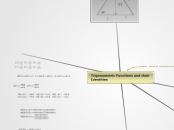PreCalculus
Chapter 8
Area of a Triangle
A = 1/2(b * h)
Law of Cosines
a^2 = b^2 + c^2 - 2bc cos A
b^2 = a^2 + c^2 - 2ac cos B
c^2 = a^2 + b^2 - 2ab cos C
Law of Sines
A + B + C = 180 degrees
sinA/a = sinB/b sinA/a = sinC/c sinB/b = sinC/c
sinA/a = sinB/b = sinC/c
Right Triangle
SOH-CAH-TOA
cotθ = 1/tanθ = b/a
secθ = 1/cosθ = c/b
csc = 1/sinθ = c/a
tanθ = a/b
cosθ = b/c
sinθ = a/c
Chapter 7
Product to Sum and Sum to Product
Sum to Product formulas
cos(a)- cos(b)= -2sin((a+b)/2)sin((a-b)/2)
cos(a)+ cos(b)= 2cos((a+b)/2)cos((a-b)/2)
sin(a) - sin(b) = 2sin((a-b)/2)cos((a+b)/2)
sin(a)+(b)sin = 2sin((a+b)/2)cos((a-b)/2)
Product to Sum formulas
sin(a)cos(b)= 1/2[sin(a+b) + sin (a-b)]
cos(a)cos(b) = 1/2[cos(a-b) + cos(a+b)]
sin(a)sin(b) = 1/2[cos(a-b) - cos(a+b)]
Double & Half Angles
Half-Angle Formula
tan(α/2) = sqrt((1-cos a)/(1+cos a))
cos(α/2) = sqrt((1+cos a)/2)
sin(α/2) = sqrt((1-cos a)/2)
Double-angle Formulas
tan^2θ = (1-cos(2θ))/(1+cos(2θ))
cos^2θ = (1+cos(2θ))/2
(sin^2)θ = (1-cos(2θ))/2
tan(2θ) = (2tanθ)/(1-tan^2θ)
cos(2θ) = 2(cos^2)θ-1
cos(2θ) = 1-2(sin^2)θ
cos(2θ) = (cos^2)θ-(sin^2)θ
sin(2θ) = 2sinθcosθ
Sum and Differences
Formulas for Tangent Function
tan(a-b) = (tan(a)- tan(b))/(1+tan(a)tan(b))
tan(a+b) = (tan(a)+tan(b))/(1-tan(a)tan(b))
Formulas for Sine Function
sin (a-b) = sin(a)cos(b)- cos(a)sin(b)
sin (a+b) = sin(a)cos(a)+ cos(a)sin(b)
Formulas for Cosine Function
cos(a-b) = cos(a)cos(b)+ sin(a)sin(b)
cos(a+b) = cos(a)cos(b) - sin(a) sin(b)
Trig Identities
An trigonometric identity is defines as two functions
are to be identical for every value of x on the functions.
Even-Odd Identites
cot(-θ) = -cotθ
tan(-θ) = -tanθ
sec(-θ) = secθ
cos(-θ) = cosθ
csc(-θ) = -cscθ
Sin(-θ) = -sinθ
Pythagorean Identities
tan^2θ+1=sec^θ
sin^2θ+cos2=1
Reciprocal Identities
cotθ=1/tanθ
secθ=1/cosθ
cscθ=1/sinθ
Quotient Identities
cotθ=cosθ/sinθ
tanθ=sinθ/cosθ
Inverse Trig Functions
If x=sin(y) then y=sin^-1(x), similar with
all other functions.
Reflective around the orgin
Range of f = domain of f^-1
Domain of f = range of f^-1
f^-1(f(x)) = x for every x in the domain of f and
f(f^-1(x)) = x for evey x in the domain of (f^-1))
Chapter 6
Trig Graphs
Transformations
Horizonal Stretch/Compression
Vertical Stretch/Compression
Horizonal Shift
Vertical shift
Trig Functions:
Cotangent Function
Range = All Real Numbers
Domain = All real numbers except for (k*pi)
1/tan or also known as cos/sin
Secant Function
Domain = Any real numbers but pi/2 or 3pi/2
1/cos
Cosecant Function
Range = (-infinity,-1]U[1,infinity)
Domain = All real numbers except integer
multiples of pi otherwise known as 180 degrees.
1/sin
Tangent Function
Range = All real Numbers
Domain = All real numbers except odd integer
multiples of pi/2 otherwise know as 90 degrees
Association of t from the ratio of y-coordinate
to the x-coordinate of P. Also known as sin/cos
Cosine Function
Associates angles of t with x-coordinates
in the circumference of a unit circle
Sine
Range = [-1,1]
Domain = All real numbers
Associates angles of t with y-coordinates in the circumference of a unit circle.
Unit Circle
Can be used to very easily find the similarities
between radians and degrees within the unit circle. To be exact.
Unit Circle equation = (x^2) + (y^2) = 1
Since there is a radius of one, the unit circle is an
easy way to find and graph points on a circle.
Angles
Subtopic
Area of a Sector Theorem
1/2(r^2)(theta)
Arc Length
The distance along the outside of a circle.
Radians
Also known as theta, radians are a new way to measure
angles within a circle. This is done by dividing the arc length by the radius of the circle. Otherwise known as S/r
Revolutions
360 degrees is the entirety of a circle
Right angles = 90degrees
Rays









